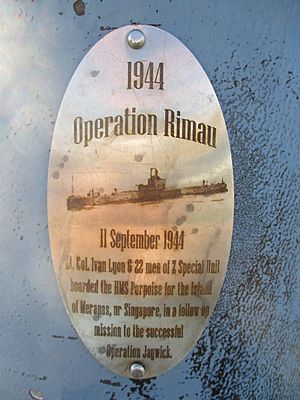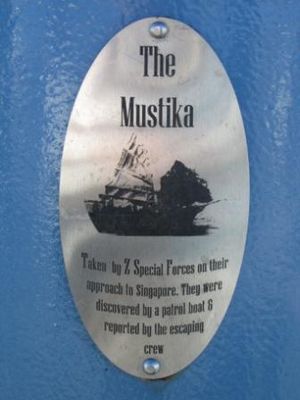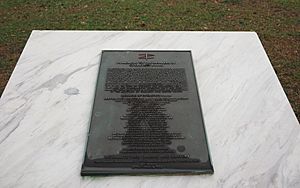Operation Rimau facts for kids
Quick facts for kids Operation Rimau |
|||||||
|---|---|---|---|---|---|---|---|
| Part of the Japanese occupation of Singapore during World War II | |||||||
 Operation Rimau commemorative marker, Rockingham, Western Australia |
|||||||
|
|||||||
| Belligerents | |||||||
| Z Special Unit | |||||||
| Commanders and leaders | |||||||
| N/A | |||||||
| Strength | |||||||
| N/A | 23 commandos 1 junk |
||||||
| Casualties and losses | |||||||
| claimed 3 ships sunk | 1 junk scuttled 13 killed or died in custody 10 executed |
||||||
Operation Rimau was a secret mission during World War II. A special team of Allied commandos, called the Z Special Unit, planned to attack Japanese ships in Singapore Harbour. They wanted to use small, foldable canoes called "folboats" and special underwater mines.
This mission was a follow-up to a successful one called Operation Jaywick from 1943. Lieutenant Colonel Ivan Lyon of the British Army led both missions. The main goal of Operation Rimau was to sink Japanese ships by attaching hidden mines to them at night. Sadly, the mission did not go as planned. The commandos were discovered by local police. Many were killed in battles with the Japanese military. Others were captured and later executed.
Contents
Planning the Secret Mission
After the success of Operation Jaywick, Ivan Lyon started getting ready for Operation Rimau. The name 'Rimau' means 'tiger' in Malay. Lyon even had a large tiger tattooed on his chest!
The team for this mission had 23 commandos. Two other officers helped guide them.
Here was the plan:
- A submarine would take the commandos close to enemy waters.
- They would use 15 special one-person, motorized canoes called "Sleeping Beauties." These canoes could travel on the surface or underwater.
- The team would go to Merapas Island in Indonesia. This island was supposed to be empty and would be their secret base. They would hide supplies there for three months.
- Next, the commandos would capture a small local fishing boat.
- They would sail this boat towards Singapore Harbour without being noticed. The commandos would dress like local people to blend in.
- On October 9, 1944, they would reach a bay called Kepala Jernih. An officer would scout the area from Pulau Subar to find targets.
- After dark, the team would move their boat to a hidden attack spot at Labon.
- Using the "Sleeping Beauties," they would attach special "limpet mines" to Japanese ships. They hoped to sink many ships.
- After the attack, they would escape back to Merapas Island. They would paddle 70 miles in two-person folboats.
- A submarine would pick them up from Merapas Island around November 7 or 8, 1944. If the submarine missed them, it would keep trying until December 8.
This mission was different from Operation Jaywick in a few ways:
- They would use special motorized canoes to deliver the mines.
- The team was larger, with 23 men instead of 14.
- They planned to capture a local boat instead of sailing one all the way from Australia.
- The captured boat would not have an engine.
Here are the brave members of the team:
- Lieutenant Colonel Ivan Lyon
- Lieutenant Commander Donald Davidson
- Major Reginald Ingleton
- Captain Robert Page
- Lieutenant Bruno Reymond
- Lieutenant Walter Carey
- Lieutenant Robert Ross
- Lieutenant Albert Sargent
- Lieutenant Walter Chapman
- Sub-Lieutenant Gregor Riggs
- Warrant Officer Alfred Warren
- Warrant Officer Jeffrey Willersdorf
- Sergeant Colin Cameron
- Sergeant David Gooley
- Corporal Archie Campbell
- Corporal Colin Craft
- Corporal Roland Fletcher
- Corporal Hugo Pace
- Corporal Clair Stewart
- Lance Corporal John Hardy
- Able Seaman Walter Falls
- Able Seaman Andrew Huston
- Able Seaman Frederick Marsh
- Private Douglas Warne
The Mission Begins
Lyon and his team left their base in Garden Island, Western Australia. They traveled aboard the British submarine HMS Porpoise. Their journey began on September 11, 1944.
The submarine reached Merapas Island on September 23, 1944. They thought the island was empty. But a quick look through the submarine's periscope showed three local Malays and a canoe on the beach.
To keep their supplies safe from the locals, Lieutenant Walter Carey stayed on Merapas Island as a guard.
The rest of the team stayed on the Porpoise. The submarine moved away on September 24 to find a local boat to capture.
Capturing the Mustika
On September 28, 1944, the Porpoise stopped a local boat called the Mustika. This boat was a type of ship called a junk from Ketapang. Seven commandos boarded the Mustika. The nine Malay crew members were taken onto the submarine.
Soon after, the Porpoise went underwater. Both the submarine and the Mustika headed towards a secret base at Pedjantan Island.
Over the next two nights, the commandos, their special canoes, folboats, and other supplies were moved from the Porpoise to the Mustika.
Once everything was moved on October 1, 1944, Major Walter Chapman and the Mustika's Malay crew returned to Australia in HMS Porpoise. The Malay crew stayed in Fremantle for the rest of the war.
The Porpoise arrived safely back in Fremantle on October 11, 1944. Later, on October 15, Chapman and Corporal Ronald Croton boarded another submarine, HMS Tantalus. This submarine was supposed to meet the Rimau team on November 8, 1944.
Back to Merapas Island
The Mustika sailed back to Merapas Island. The Rimau Commandos dressed like Malays. They even dyed their skin to look more like locals. The Mustika had no engine, so they had to rely on the wind to move.
The Mustika arrived at Merapas on October 4, 1944. Lyon decided to split the team into two groups. Nineteen commandos would take part in the main raid. Four men would stay behind.
The Mustika then sailed towards Singapore Harbour. It reached the area around October 6, 1944. The plan was to launch the attack from Pulau Laban, which was about 11 miles from Keppel Harbour.
Contact with the Japanese
On October 10, 1944, disaster struck. It was two hours before sunset, and the raid was about to begin. A Malay Police patrol boat, the Hei Ho, approached the Mustika near Kasoe Island. The Japanese had increased their patrols in the area since Operation Jaywick.
It's not clear why the patrol boat came closer. Maybe the Mustika flew the wrong flag, or it looked suspicious. Some say the patrol boat saw white men on board, not Malays.
Shots were fired between the boats. It seems one of the Australian commandos panicked and started shooting. Some of the patrol boat crew were killed. But at least one person escaped and reported the incident.
Lyon knew the patrol boat would get help from the Japanese. He decided to stop the mission. He sank the Mustika and the secret "Sleeping Beauties" using explosives. He then ordered his men to split into four groups. They were to use their folboats to get back to Merapas Island. The groups were led by Lyon, Davidson, Page, and Ross.
Attack on Singapore Harbour
Three of the groups headed straight for Merapas. But Lyon led his group into Singapore Harbour. His group had six other men: Lieutenant Commander Donald Davidson, Lieutenant Bobby Ross, Able Seaman Andrew Huston, Corporal Clair Stewart, Corporal Archie Campbell, and Private Douglas Warne.
It is believed they managed to sink three ships using limpet mines. However, there is not much proof to confirm this.
The Imperial Japanese Army in Singapore sent a large force of at least 100 soldiers to find the commandos.
Initial Escape
Some of the folboat groups likely stopped on the northern part of Batam Island. Batam had been used as a hiding place during the earlier Jaywick mission.
On October 14, 1944, some commandos were reported on Pankgil Island. Japanese soldiers were sent there but did not find them.
Battle of Soreh Island
On October 15, five of the men (Lyon, Davidson, Ross, Stewart, and Campbell) were on Soreh Island. This is a small island near Pankgil Island.
A Japanese patrol found them around 2 PM. A gun battle started. The Australians moved to a hidden spot on the beach.
The Australians ambushed the Japanese soldiers and their helpers. Davidson and Campbell were badly hurt. Lyon, Ross, and Stewart stayed on Soreh to fight off the Japanese. This allowed the wounded men to escape.
Lyon, Ross, and Stewart fought against 80 to 90 enemy soldiers for nine hours. They caused many casualties. Lyon and Ross climbed trees to get a better shooting position. They stayed hidden until the flashes from their guns gave away their spots. They were then killed by grenades. Stewart managed to escape for a while, but his folboat was taken. He was found days later during a search of the island.
Merapas Island
By November 4, eighteen of the group were together on Merapas Island. A small Japanese force landed on the island. The commandos attacked them. Two of the Rimau commandos, Riggs and Sergeant Colin Cameron, were killed in the fight. The remaining men then split into two groups and went to different islands.
The bodies of Riggs and Cameron were found on Merapas in 1994.
Rescue Mission
Australian forces found a secret Japanese message. It said that about twenty commandos were active in the attack area. But if the Australians had responded, it would have shown that they had broken the Japanese secret codes. So, the rescue submarine was not told about the urgent situation.
The orders for the rescue submarine, HMS Tantalus, were to go to Merapas Island on November 7, 1944. It was supposed to stay there until December 7, if needed.
The Tantalus left Australia on October 15, 1944.
On November 7, 1944, ten of the Rimau commandos were ready to meet the rescue submarine. But it did not appear. The submarine's commander, Lieutenant Commander Hugh Mackenzie, decided to hunt for enemy ships instead. He made this choice with Major Chapman, who was the Z Special Unit's contact on the submarine. The Tantalus's main goal was to attack the Japanese. The Rimau party's orders said they might be picked up any time within a month of the first meeting date.
On November 21, 1944, the submarine reached Merapas Island. Chapman and another commando, Corporal Croton, were worried about the waves. They took their landing folboat around the island to calmer waters. Chapman wanted to go back to the submarine, but Croton made him continue.
Croton and Chapman reached the meeting point after sunrise on November 22, 1944. They found some signs that the commandos had been there. There was a large shelter being built, empty food tins, and half-cooked food. They also saw fires that looked like they had been put out quickly. They did not ask local people what had happened.
Croton and Chapman returned to the submarine. Chapman and Mackenzie agreed that the mission had likely failed. They decided there was no reason to go back to Merapas.
The Tantalus continued its patrol and returned to Fremantle on December 6, 1944. It never went back to Merapas Island.
No officials in Australia who knew the Rimau commandos were in trouble tried to contact the submarine. They did not order it to stay in the area for any survivors.
Attempted Escape
Once the final deadline of December 7, 1944, passed, the survivors knew they would not be rescued. They tried to make their way home to Australia, a distance of 3,000 kilometers.
Over the next two weeks, almost all the men were captured, killed in fights, or drowned.
Two men, Willersdorf and Pace, were captured on January 17, 1945, on Romang Island, Indonesia. This was about 350–400 miles from Australia, after they had traveled about 2,000 miles by folboat. Willersdorf died from his wounds while held by the Japanese in Dili, East Timor, in March 1945. Pace died of starvation a few months later in June 1945 at the same place. Both were buried on a hill near the prison.
Warne managed to avoid Japanese patrols until March 1945. But he was captured after becoming very sick with a fever. He was taken to Surabaya and questioned harshly. He died a month later from his untreated injuries.
Capture and Execution
In total, eleven members of the team were captured. They were taken to Outram Road Prison in Singapore. One commando, Marsh, died from malaria while imprisoned. The men were treated very badly and given very little food.
On July 3, 1945, they were put on trial. They were accused of being spies. They were found guilty and sentenced to death.
Japanese records state that the ten men were executed on July 7, 1945. This was about one month before World War II in the Pacific ended.
The men who were executed were:
- Major Reginald Ingleton
- Captain Robert Page
- Lieutenant Albert Sargent
- Lieutenant Walter Carey
- Warrant Officer Alfred Warren
- Sergeant David Gooley
- Corporal Clair Stewart
- Corporal Roland Fletcher
- Able Seaman Walter Falls
- Lance Corporal John Hardy
Their bodies were buried in unmarked graves.
Nineteen of the Rimau commandos, including Lyon, are buried at Kranji War Memorial in Singapore. The bodies of two men (Riggs and Cameron) were found on Merapas Island in 1993. Local people who were there at the time of their deaths helped find them. Their bodies were moved to Singapore for burial in August 1994.



